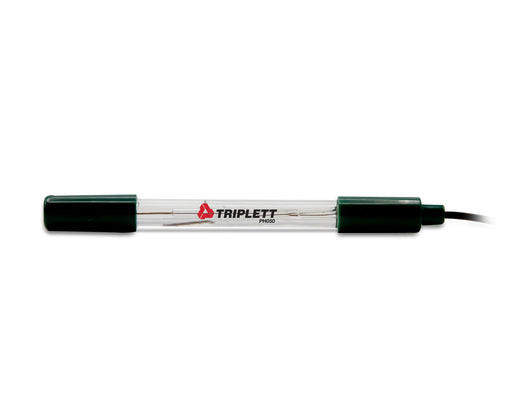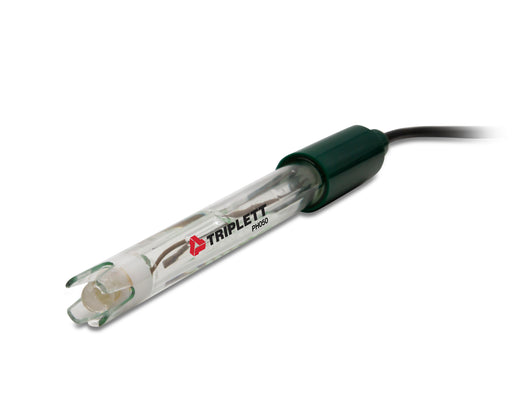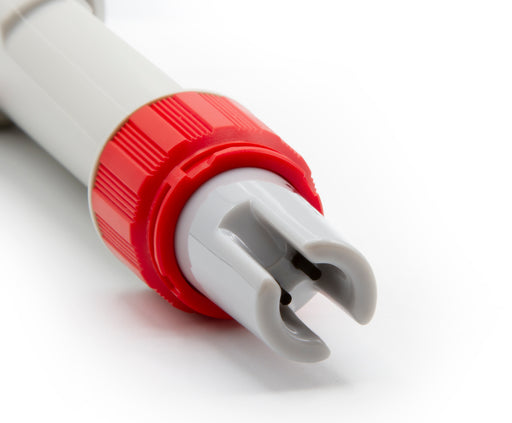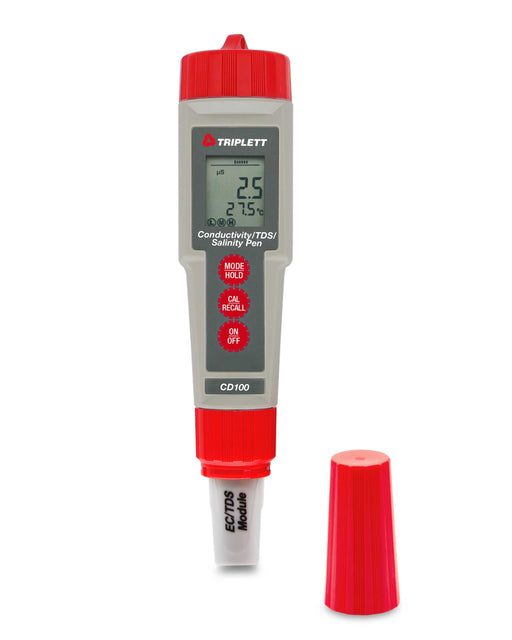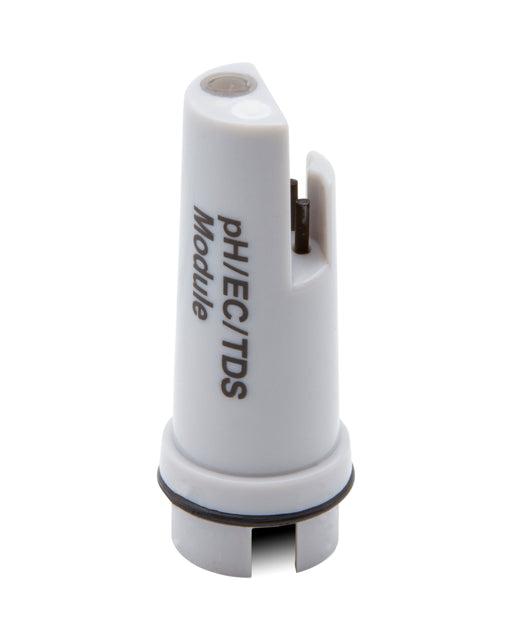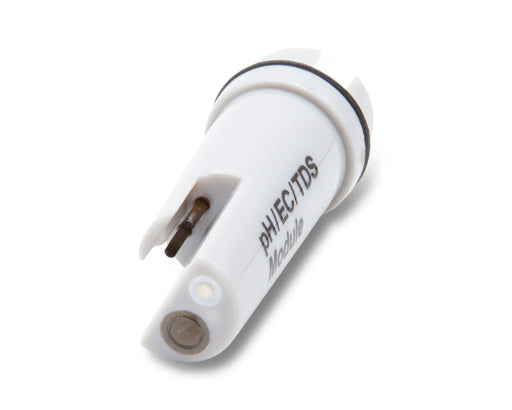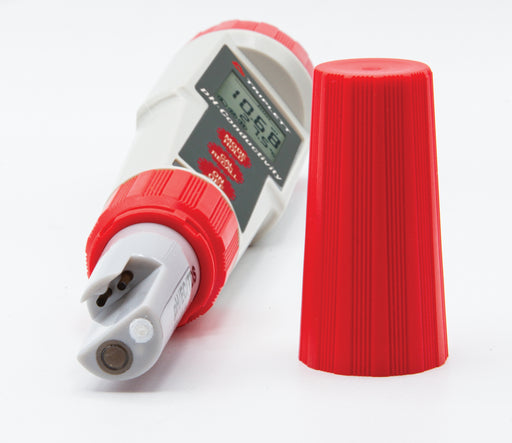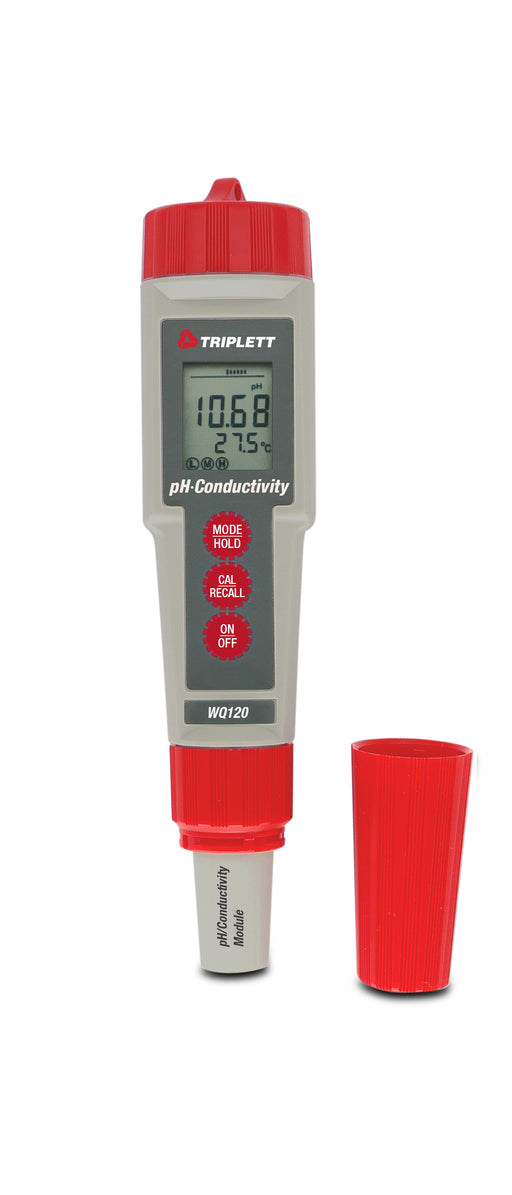PH and Conductivity Meters
Triplett offers a variety of digital pH and conductivity meters which are compact and handy. We also offer pH and conductivity analyzers with the capability to measure other parameters such as total dissolved solids (TDS), salinity, and so on. Most of these models are calibrated for conductivity, and can save up to around 25 readings in their memory. They come with a display screen and an auto power off mode. These models are waterproof and assure long term performance. pH is the hydrogen ion concentration in a fluid which makes it acidic, alkaline, or neutral. Conductivity relates to electrical conductivity which comprises measuring the concentration of negative as well as positive ions based on the capacity to let the current flow in a particular area. Digital pH and conductivity meters are used to measure both these factors as they are related. The level of hydrogen ions and a number of other types of ions determines the acidity and alkalinity as well as impact the conductivity of that substance.
Filters
Categories
-
Building, Maintenance, and Environmental
- Borescopes & Inspection Cameras
- Laser Distance Meters
- Photo & Contact Tachometers
- Manometers
- CO & CO2 Meters
- F Connectors
- Combustible Gas Detector and Pen
- Humidity Indicators & Meters
- Pin & Pinless Moisture Meters
- Thermometers
- Light Meters
- Sound & Noise Level Meters
- Particle Counter
- Thermo Anemometers
- Hygro-Thermometers
- Hygrometer
- Special Kits
- Refractometer
- Coating Thickness Testers
- PH and Conductivity Meters
-
Electrical Test & Measurement
- Analog Meters -Voltmeters
- Clamp Meter
- Digital Multimeters
- Railroad Test Sets
- Voltage & Current Dataloggers
- Magnetic Field Detectors
- AC Voltage Detector
- Continuity Testers
- Test Leads
- Multimeter Case
- GFCI Receptacle Testers
- Electrical Hand Tools
- Non-Contact Voltage Detection Pens
- Circuit Breaker Tracers
- Special Kits
- Megohmmeters - Insulation Testers
- Power Supplies
- Motor & Phase Rotation Testers
-
Security, CCTV & Cabling Equipment
- Security Camera Testers
- CCTV HD LED Test Monitors
- Baluns, Ground Loop Isolators
- HDMI & IP Extenders
- All Cables
- HDMI Cables
- CAT6a Shielded Cable
- Ethernet Network Cables
- CCTV BNC Adapters
- BNC Connectors
- F Connectors
- BNC Compression Connectors
- CAT5 & CAT6 Connectors
- CCTV Coax Connectors
- Modular Connector
- Between Series Adapters
-
Best SellerOriginal price $107.00 - Original price $107.00Original price$107.00$107.00 - $107.00Current price $107.00| /
Long Tube Stem pH Meter - (PH325)
Triplett Test Equipment & ToolsIn stockThe Triplett Model PH325 Long Tube pH Pen Long Tube pH Pen is an advanced pH measurement tool designed for precision and convenience. Its distincti...
View full detailsOriginal price $107.00 - Original price $107.00Original price$107.00$107.00 - $107.00Current price $107.00| / -
Original price $71.00 - Original price $71.00Original price$71.00$71.00 - $71.00Current price $71.00| /
Mini pH Electrode w/BNC Connector - (PH050)
Triplett Test Equipment & ToolsIn stockThe Triplett Model PH050 Mini pH electrode with sealed gel reference solution and detachable bulb guard can be used with any pH meter that has a BN...
View full detailsOriginal price $71.00 - Original price $71.00Original price$71.00$71.00 - $71.00Current price $71.00| / -
Original price $163.00 - Original price $163.00Original price$163.00$163.00 - $163.00Current price $163.00| /
Conductivity/TDS/Salinity Pen - (CD100)
Triplett Test Equipment & ToolsIn stockThe Triplett Model CD100 waterproof (IP57) Conductivity/TDS/Salinity Pen measures TDS, Conductivity, Salinity and Temperature. It simultaneously di...
View full detailsOriginal price $163.00 - Original price $163.00Original price$163.00$163.00 - $163.00Current price $163.00| / -
Original price $100.00 - Original price $100.00Original price$100.00$100.00 - $100.00Current price $100.00| /
PH/Conductivity Electrode for WQ120 - (WQ125)
Triplett Test Equipment & ToolsIn stockThe Triplett Model WQ125 is a combination flat surface pH electrode with a multi-range conductivity cell to measure pH, TDS, Conductivity, Salinity...
View full detailsOriginal price $100.00 - Original price $100.00Original price$100.00$100.00 - $100.00Current price $100.00| / -
Original price $241.00 - Original price $241.00Original price$241.00$241.00 - $241.00Current price $241.00| /
PH/Conductivity/TDS/Salinity Meter - (WQ120)
Triplett Test Equipment & ToolsOut of stockThe Triplett Model WQ120 waterproof (IP57) PH/TDS/Conductivity/Salinity Pen combines a flat surface pH electrode with a multi-range conductivity ce...
View full detailsOriginal price $241.00 - Original price $241.00Original price$241.00$241.00 - $241.00Current price $241.00| /Out of Stock -
Original price $67.00 - Original price $67.00Original price$67.00$67.00 - $67.00Current price $67.00| /
PH Electrode for PH180 - (PH185)
Triplett Test Equipment & ToolsIn stockThe Triplett Model PH185 is a replacement flat surface electrode for the PH180 PH Pen. It can be used to measure pH in liquids, semi-solids or any...
View full detailsOriginal price $67.00 - Original price $67.00Original price$67.00$67.00 - $67.00Current price $67.00| / -
Best SellerOriginal price $156.00 - Original price $156.00Original price$156.00$156.00 - $156.00Current price $156.00| /
Waterproof PH Meter - (PH180)
Triplett Test Equipment & ToolsIn stockThe Triplett Model PH180 Waterproof (IP57) PH Pen measures from 0 to 14 pH with 0.01pH resolution and has flat surface electrode that can measure s...
View full detailsOriginal price $156.00 - Original price $156.00Original price$156.00$156.00 - $156.00Current price $156.00| /
Know More About Triplett PH and Conductivity Meters
What is conductivity and pH?
Hydrogen ion concentration or pH is a term used to define the hydrogen-ion activity of a system. This chemical activity allows us to determine, for example, the acidity (0-6 pH) or alkalinity (8-14 pH) of a solution (pH of 7 is neutral). The conductivity range is from 0-200µS, 200-2000µS, 2-20mS (0.1µS) for most models. pH and conductivity measurement are related in terms of measuring the quantity of ions in a given sample. So, electrical conductivity is the measurement of all the positive as well as negative ions, while pH measurement comprises hydrogen ions. We offer pH and conductivity probe with the capability of measure a variety of other parameters.
Applications of pH and Conductivity Meters
pH and conductivity meters are used in environmental monitoring. They can be used to monitor the quality of drinking water, to monitor the success of water treatment plants, or to monitor the health of rivers and lakes. pH and conductivity meters can also be used in agricultural settings, to monitor the quality of irrigation water or to monitor the success of crop treatments. The other applications of the device include;
- Aquarium and Aquaculture: Monitoring water quality is essential for the health and well-being of your fish and plants in aquarium and aquaculture system. pH and conductivity meters are essential tools for monitoring and maintaining water quality as these meters provide quick and accurate measurements of pH, conductivity, and temperature, allowing you to keep your water quality within the optimal range for your fish and plants.
- Boiler Feed Water Treatment: Conductivity and pH meters are essential tools in boiler feed water treatment. By measuring the conductivity and pH of the water, treatment plant operators can make adjustments to the boiler feed water to ensure it is within the correct range. This helps to prevent boiler corrosion and scale formation, which can lead to expensive repairs or even plant shutdown.
- Pools and Spas: pH and conductivity meters are essential for ensuring that pools and spas are safe and enjoyable for all. There are many different applications for pH and conductivity meters in pools and spas. For example, you can use them to test the water's pH before adding chemicals, or to make sure the water is properly balanced after adding chemicals.
- Food and Beverage: pH and conductivity meters are used in the food and beverage industry, including quality control, product development, and process optimization. They are commonly used to measure the acidity of juices, dairy products, and other food products. They can also be used to measure the level of dissolved ions in beer, wine, and other beverages. In addition, pH and conductivity meters are often used to optimize food and beverage processes, such as fermentation and pasteurization.
How does a pH and conductivity meter work?
Electrical conductivity is measured with the help of electrodes on the probe. They are submerged in the fluid and current is passed through it. With this, the concentration of all types of ions can be determined. There is a pH meter or electrode which is dipped in a buffer solution which works as a reference point. All this is measured digitally and displayed on the screen.
Can a pH meter measure conductivity?
Yes, a pH meter can measure conductivity and many other parameters such as salinity, TDS, temperature, and so on. This is possible, as most models of our pH meters work as multimeters and are programmed to measure all of these factors in standard units. You can choose the units to suit your application preferences and set the probe output accordingly.
How does a conductivity meter work?
This measures electrical conductivity and is most often combined as pH and conductivity probe. For some applications, both pH and total ion concentration are required as process parameters. Most models we offer have an accuracy rate of ±2% FS.
What is the principle of a pH meter?
Any solution or fluid with more number of H+ ions than OH- ones would be acidic, while the one with OH- ions in majority is alkaline. When both the ranges are almost equal the solution is said to have a neutral pH of 7. While this pH value can be tested with simple pH paper strip, for more accurate outputs pH meters are used, especially in manufacturing units. While a regular pH meter measures the hydrogen ion concentration, a pH and conductivity probe measures the differential value, which separates the hydrogen ions from the total ions.
What is pH meter calibration?
pH meters need to be calibrated on a timely basis or after each day’s use to maintain accuracy. This is done by preparing three different buffer solutions- acidic with pH 4, neutral with pH 7, and alkaline with pH 9.2. Check the manufacturer’s instruction manual for the standard procedure. The probes must be calibrated at room temperature or round 25 degrees Celsius. Dip the pH electrode in each solution. However, as a rule start with neutral pH. Measure the temperature of the solution and that of the knob. Activate the function switch for pH and adjust the calibration control to pH 7. Set the function switch on standby mode. Now remove the electrode and use distilled water to wash it. Repeat this process for calibrating acidic and then basic pH values.
Browse More Building, Maintenance & Environmental Collections
Inspection & Laser Distance Meters:
| Borescope Inspection Camera | Photo & Contact Tachometers |
| Manometers | Laser Distance Meters |
Gas Meters:
| Natural Gas Detector and Pen | Formaldahyde Meters | Co & Co2 Meters |
Environmental Meters:



